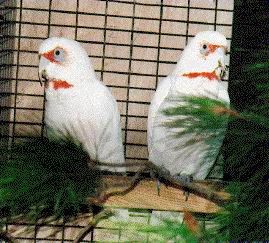Corella - Long Billed, Western
Scientific Name: Cacatua tenuirostris pastinator
Sat, 19th July, 2025 - 3:06 am GMT
Sponsor Ads:

Alternative Name
Scientific Name: Cacatua tenuirostris pastinatorBasic Info
Western Long-billed Corellas have long upper mandibles, of course, which are ivory colored! The entire bird grows to about 38 centimeters in length. They have white plumage, which is yellowish under the tail and wings. There is a large blue-gray, saggy area of skin about the eye, which lacks feathers. Western Long-billed Corellas are characterized by the orange-red coloring they have about their necks, napes, breasts, flanks and in the area of their nostrils. Their irises are brown and there is a stripe above the Western Long-billed Corella's eye and a band, which runs to their throat. Their white crests are rather small and their feet are bluish gray. Western Long-billed Corellas must be DNA sexed.
Health
Because Western Long-billed Corellas may be slightly aggressive toward other birds, they should be kept in pairs. They are extremely noisy and may be considered a nuisance to your neighbors! Western Long-billed Corellas must be wormed regularly. Breeding Western Long-billed Corellas in captivity need a variety of nesting boxes and even then do not often breed. Generally, a 90-centimeter log with a 35-centimeter internal diameter works well. Provide peat moss, dirt and wood shavings as nesting material. A typical clutch consists of one to three eggs, which incubate for 24 days. The young fledge at about seven to ten days. Breeding is easiest if your pair of Western Long-billed Corellas has been raised together, and are isolated by themselves in an aviary with an excellent nutritional diet. A second clutch will only be produced if the first is lost.Habitat
N/ABehavior
The Long-billed, or Slender-billed Corella is an interesting Cockatoo who lives both in the wild and in captivity throughout Australia. It consists of two subspecies: the Eastern and Western Long-billed Corellas. Western Long-billed Corellas make darling aviary birds and are known by the scientific name of Cacatua tenuirostris pastinator. Western Long-billed Corellas are generally found near watercourses in grassy areas or open woody areas. They are highly social, gregarious birds and gather at feeding sites in flocks of hundreds of birds! Often, Long-billed Corellas will associate with the Sulphur-crested Cockatoo. While feeding, one bird will remain in a tree and keep watch while the others feed. They only feed during the cooler hours of the day, preferring to rest at midday in shade. Western Long-billed Corellas, when disturbed, will shriek loudly while taking wing. They feed mostly on roots and onion grass supplemented with all sorts of seeds, vegetation and fruits in addition to insects. From July to November, Western Long-billed Corellas breed, making their nests in hollow treetops or branches. They have been observed making burrows in soft dirt banks when they cannot find a suitable tree. Both the male and female Long-billed Corellas tend to the young and sit on the eggs! In captivity, the Western Long-billed Corella is noisy and social and will thrive in a four by two by two-meter aviary with a sheltered section and safe from frost. Although Western Long-billed Corellas get along well with other like-sized birds, they do get aggressive around breeding time. Because their bills are used to dig wild roots, they must have an aviary with a cement floor, and will be very destructive to wood because they love to chew. When hand-reared, Western Long-billed Corellas bond very strongly with their owner and learn to talk quickly. They live more than 50 years!Origin
AustraliaHistory
In cultivated areas, Long-billed Corellas can seriously harm grain or millet and rice fields, and are endangered in some areas because they are persecuted as agricultural pests. First recognized by Kuhl in 1820, Long-billed Corellas are native to southeastern Australia. Of the two subspecies of Long-billed Corella, Western Long-billed Corellas inhabit the eastern parts of the range. They have been crossed with Major Mitchell's, Sulphur-crested, and Galah Cockatoos.Common Foods
They should be fed a good pellet diet in addition to a variety of fresh fruits and vegetables supplemented with hard-boiled eggs.Sponsor Ads:
Imagination is more important than knowledge. -- Albert Einstein
Corella - Long Billed, Western
Coded by: BGID® | ALL RIGHTS RESERVED Copyright © 2000-2025
Disclaimer | Privacy | Report Errors / Contact | Credits


 Why haven't we as a collective earth met with aliens yet?
Why haven't we as a collective earth met with aliens yet?  World EcoSystem - Biodiversity Changes - Who is on board and who isn
World EcoSystem - Biodiversity Changes - Who is on board and who isn  Homosexual behavior stems from the mind or genetics?
Homosexual behavior stems from the mind or genetics?  The Best Text Adventure You Will Ever Play! The official site:
The Best Text Adventure You Will Ever Play! The official site:  Mouthwash - Mouthrinse - Mouth Sores - Healing Infections - Gingivitis
Mouthwash - Mouthrinse - Mouth Sores - Healing Infections - Gingivitis  Treatment for Depression
Treatment for Depression  Ultra radical and violent Islamist group that even rivals Al Qaeda
Ultra radical and violent Islamist group that even rivals Al Qaeda  An idea to have teachers who want to carry guns to school undergo some level of police training will be left up to local school districts and police departments.
An idea to have teachers who want to carry guns to school undergo some level of police training will be left up to local school districts and police departments.